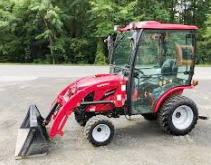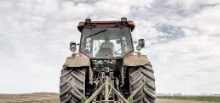________________________________________________________________________________________
| Home / Farm Tractors / Mahindra Tractors / Mahindra eMax 25S |
Mahindra eMax 25S Troubleshooting
 The
Mahindra eMax 25S is a 4WD sub-compact utility tractor from eMax S series. This
model was manufactured from 2017 to 2019. The components of Mahindra eMax 25S
powerline system: a 61.5 cubic inches (1L) Daedong 3C100LF four-stroke
three-cylinder indirect injection naturally aspirated liquid-cooled diesel
engine with a rated power of 25 Hp (18.5 kW), and hydrostatic transmission with
infinite forward and reverse gears. The maximum travel speed (forward/reverse):
10.2 mph (16.4 km/h) and 10 mph (16 km/h).
The
Mahindra eMax 25S is a 4WD sub-compact utility tractor from eMax S series. This
model was manufactured from 2017 to 2019. The components of Mahindra eMax 25S
powerline system: a 61.5 cubic inches (1L) Daedong 3C100LF four-stroke
three-cylinder indirect injection naturally aspirated liquid-cooled diesel
engine with a rated power of 25 Hp (18.5 kW), and hydrostatic transmission with
infinite forward and reverse gears. The maximum travel speed (forward/reverse):
10.2 mph (16.4 km/h) and 10 mph (16 km/h).
The open center hydraulic system includes a gear pump with rated fluid flow of 4.5 gal/min (17 l/min). The Mahindra eMax 25S is equipped with a hydrostatic power steering system, wet disc brakes, 6.00x12 front tyres, and 9.50x16 rear tyres. The wheelbase is 57" (1450 mm). The tractor is compatible with a 60" mid-mount 3-blade side discharge Mahindra 25M mower deck with cutting height of 1-4" (25-102 mm), Mahindra eMax 25L front end-loader with a maximum lift height of 75.3" (1910 mm), and Mahindra eMax 26B backhoe with max digging depth of 76.3" (1940 mm).
| Diesel Engine Troubleshooting |
| Diesel engine hard to start or doesn't start |
There is air in the fuel system - Bleed the system.
Fuel filter plugging - Change filter element.
Clogged injection nozzle - Clean or change injection nozzles.
Water in the fuel system - Change fuel and repair fuel system.
Excessive valve clearance - Adjust valve clearance.
Fuel injection pump is damaged - Repair or install new pump.
| Engine stalls after starting |
Air filter is dirty - Change air filter element.
Fuel filter element is dirty - Clean or change the filter.
Fuel injection pump has loose connections - Tighten the connections.
Fuel injector fault - Clean fuel injectors or change it.
Fuel injection pump is not working correctly - Change pump or rebuild it.
| Engine stalls while running |
Coolant temperature is low - Warm up to required temperature.
Fuel filter plugged - Replace the filter element.
Air in fuel tank - Bleed fuel tank.
Clogged injection nozzle - Test injection nozzles and change if necessary.
Incorrect adjustment of fuel injection pump timing - Set up as recommended.
| Engine stalls when idle |
Low idle speed setting is not correct - Test and adjust.
Fuel injection pump is defective - Repair or install a new fuel pump.
Defective fuel injectors - Clean or replace fuel injectors.
Valve out of adjustment - Have it adjusted.
| Engine power is too low |
Dirty air cleaner - Replace air filter element.
Faulty fuel injection nozzles - Service or change injection nozzles.
Improper fuel injection pressure - Check the fuel injection pressure and adjust if necessary.
Excessive valve clearance - Check and adjust.
Low idle speed set incorrectly - Test and adjust.
Fuel lines or hoses are clogged - Clean fuel system hoses and lines.
Worn cylinder head gasket - Install new cylinder head gasket.
Piston rings are damaged or leaking - Replace the piston rings as required.
| Engine overheats |
Coolant level is low - Add coolant fluid and inspect the cooling system for leaks.
Engine oil level is low - Fill the crankcase with engine oil.
Defective radiator cap or clogged radiator core - Clean radiator or change cap.
Loose or damaged fan belt - Replace the fan belt.
Diesel engine overloaded - Shift to lower gear or reduce the load.
| Low oil pressure |
Insufficient engine oil - Add oil as required.
Engine oil filter is plugged - Change or service engine oil filter.
Different type of engine oil - Fill up with the correct oil viscosity.
Incorrect oil clearance in main bearing - Change bearings.
Oil pump malfunction - Inspect and change as required.
| Abnormal engine knocking or noise |
Not enough engine oil - Fill up the engine oil.
Engine has not warmed up to the recommended temperature - Warm up to required temperature.
Fuel injection pump timing is not adjusted - Adjust fuel injection pump as required.
Too low idle RPM - Adjust low idle speed.
Damaged or clogged injectors - Inspect fuel injectors and change as required.
Connecting rod is worn or misaligned - Connecting rod needs to be replaced or aligned.
Pistons are scored or worn - Replace the pistons.
| Hydrostatic Transmission Troubleshooting |
| Hydrostatic transmission is excessively noisy |
Transmission fluid is dirty or fluid level is too low - Pour fresh fluid or add transmission fluid to proper level.
Speed control linkage is worn or unadjusted - Change or adjust linkage.
Relief valve is damaged - Change relief valve.
Transmission overloaded - Reduce transmission load.
Defective or worn transmission parts - After disassembling and inspection, change defective components.
| Power is insufficient |
Lack of transmission oil supply - Add oil to the transmission housing.
Relief valve malfunction - Change relief valve.
Speed control linkage is worn or unadjusted - Adjust or change linkage.
| Transmission oil overheating |
Transmission fluid insufficient - Check and refill the transmission fluid.
Transmission fluid filter element clogging - Service or replace the transmission fluid filter.
Damaged or clogged cooling components - Inspect all cooling components and replace or repair if necessary.
Transmission overload - Load needs to be reduced.
| External oil leaks |
Worn seals or gaskets - Replace worn seal or gaskets.
Internal transmission housing pressure is too high - Change defective parts.
Clogged oil return pipe - Clean or change return pipe.
| Hydraulics Troubleshooting |
| Low hydraulic system pressure |
Low hydraulic fluid level - Checking hydraulic fluid level and add if necessary.
Clogged hydraulic fluid filter element - Clean the hydraulic filter or install new filter element.
Damaged hydraulic pump - Replace or repair hydraulic fluid pump.
Hydraulic control valve block is set improperly - Set properly.
Hydraulic cylinder is defective - Replace or repair hydraulic cylinder.
Leaks in hydraulic lines - Identify leaks in the system and repair it.
| Excessive hydraulic system heat |
Defective main relief valve - Relief valve need to be replaced.
Improper hydraulic fluid type - Use the proper type of hydraulic fluid.
Dirty hydraulic fluid - The fluid must be changed.
Air in hydraulic pipes - Bleed hydraulic pipes.
| Three-point hitch cannot be lifted or lifting is too slow |
Excessive load on hitch - Reduce loading.
Insufficient hydraulic oil - Fill the system to proper hydraulic oil level.
Hydraulic fluid filter element is clogged - Clean the hydraulic filter element or replace if necessary.
Faulty hydraulic pump - Replace or repair hydraulic fluid pump.
Main relief valve is defective - Relief valve replacement required.
Hydraulic control valve block is defective - Repair or change hydraulic valve.
Hydraulic cylinder failure - Repair or install a new hydraulic cylinder.
Suction line is disconnected or broken - Replace or connect correctly.
| 3-point hitch won't lower or lowers slowly |
Incorrect setting hydraulic spool valve - Use the correct setting.
Hydraulic cylinder not working - Change or repair hydraulic cylinder.
3-point hitch is out of adjustment - Adjustment is required.
Lift arm shaft is damaged - Replace the shaft.
| Hitch lifting or lowering is jerky |
There is air in the hydraulic system - Bleed hydraulic system.
Dirty hydraulic oil - The oil must be changed.
Faulty hydraulic pump - Replace or repair hydraulic oil pump.
Defective hydraulic control valve - Repair or replace the valve.
Hydraulic cylinder malfunction - Change or repair hydraulic cylinder.
| Steering System Troubleshooting |
| Steering is stiff |
Improperly mounted or worn steering column - Mount the steering column as required or change it.
Air in steering system - Bleed air from system.
Incorrect toe-in - Check toe-in and correct.
Uneven tyre pressure - Inflate the tyres properly.
Steering pump malfunction - Steering pump needs to be repaired or replaced.
Steering pump control valve is stuck or faulty - Install a new flow control valve or clean it.
Low steering fluid level - Fill the steering system with fluid.
| Excessive free play of steering wheel |
Steering column coupling or shaft is extremely worn out - Change faulty component.
Hydraulic steering pump is defective - Replace or repair steering pump.
Worn or loose steering linkage joints - Check and change as required.
| Tractor is pulling to right or left |
Uneven tire pressure - Inflate the tires properly.
Improper toe-in - Check toe-in and correct.
Loose or worn steering linkage components - Check and change as required.
Front wheel bearings are damaged or incorrectly adjusted - Replace or adjust the bearings correctly.
| Electrical Troubleshooting |
| Battery won’t charge |
Loose or corroded electrical wiring connections - Tighten or service cable connections.
Faulty electrical terminal connectors - Change terminal connectors.
Worn-out battery - Use a new battery.
Worn or loose belt - Replace belt or adjust belt tension.
| Starter turns slowly |
Low battery output - Charge the battery.
Battery is not holding charge - Service battery or change it.
Corroded battery terminals or disconnected wires - Connect wiring properly or install new terminals.
| Starter is not working |
Battery is discharged or worn - Charge or change the battery.
Battery cables are disconnected or improperly connected - Inspect cables and connect properly.
Low battery capacity - Battery needs to be recharged.
Damaged starter motor - Replace or repair starter.
________________________________________________________________________________________
________________________________________________________________________________________
| Farm Tractors Technical Specifications |
